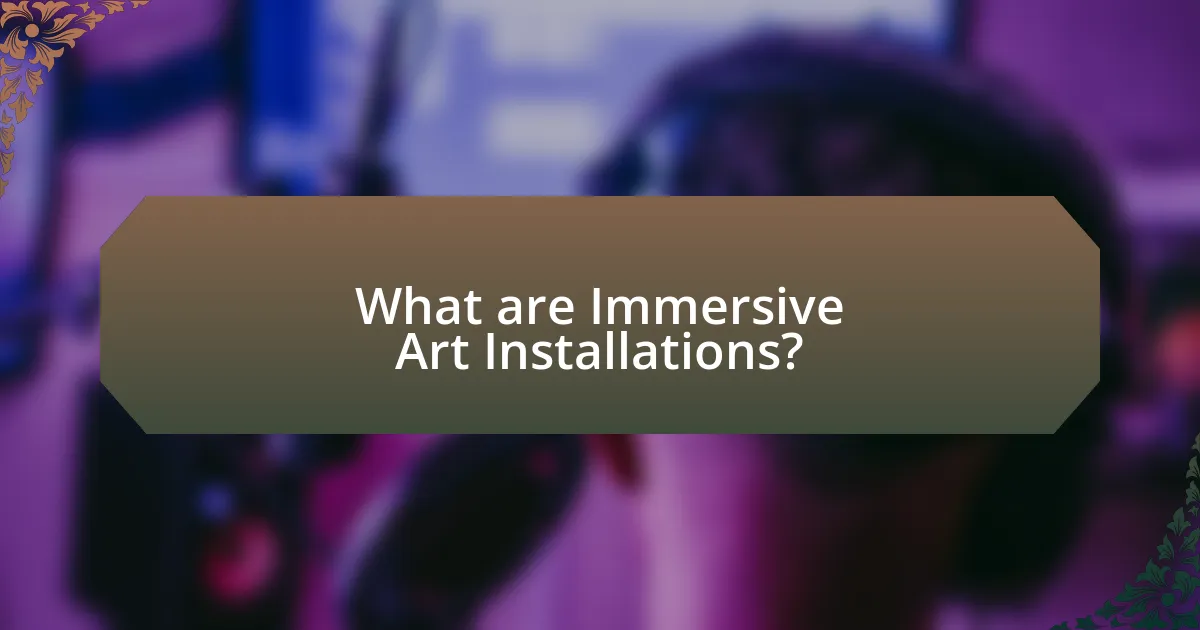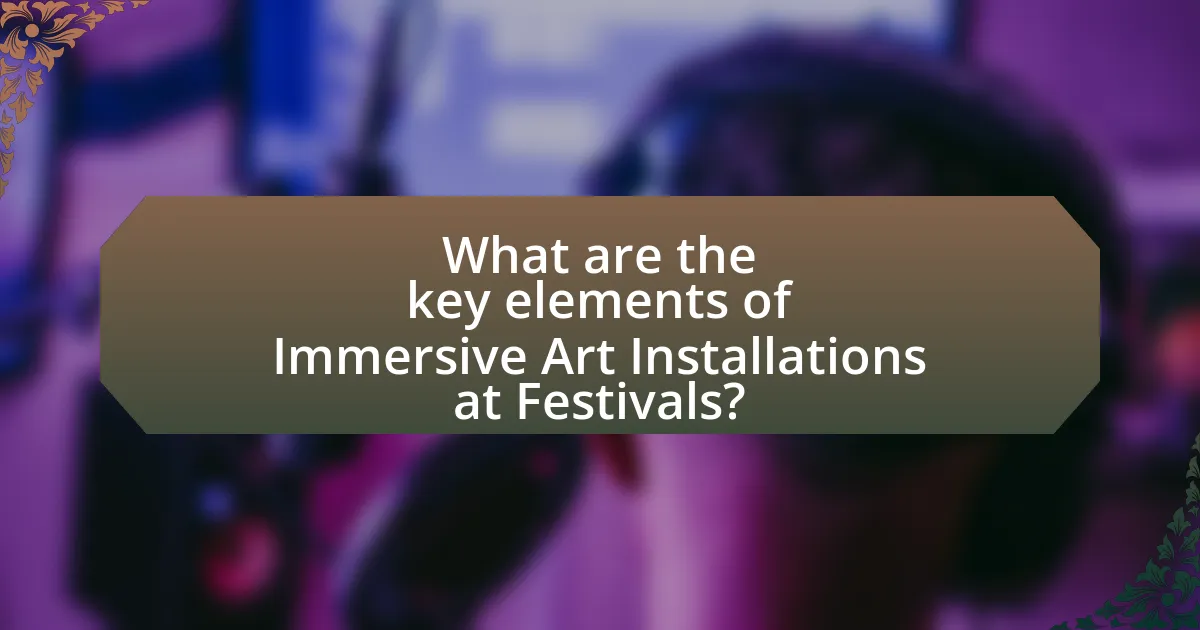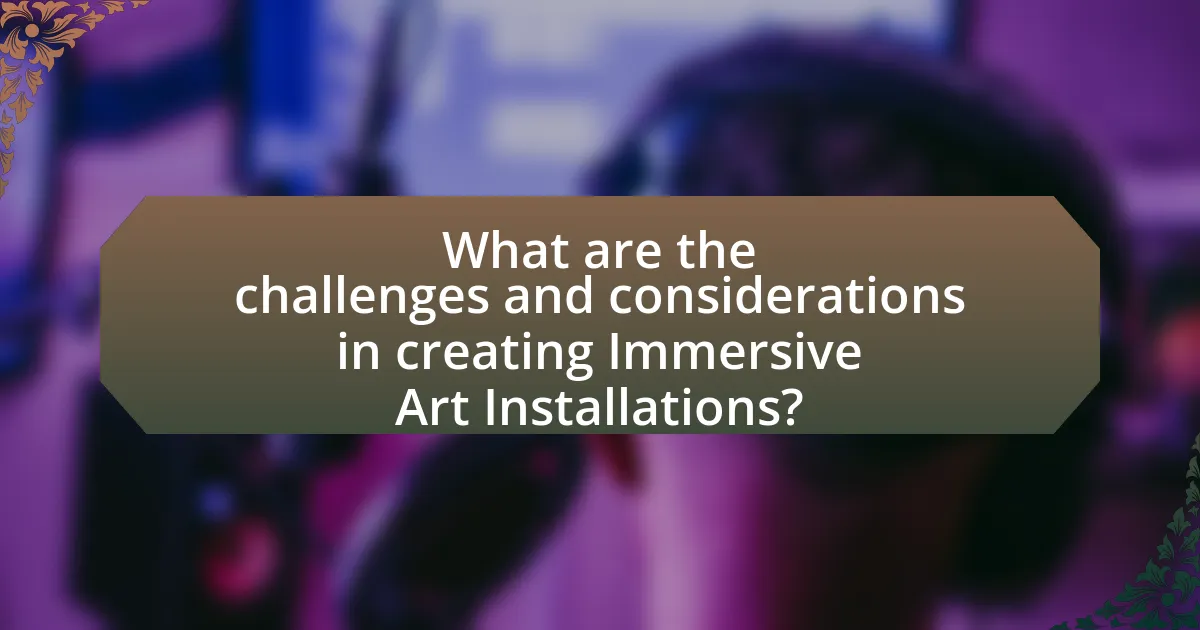Immersive art installations are interactive environments that blend visual art, sound, and technology to engage viewers through multi-sensory experiences. This article explores how these installations combine visual elements and music to enhance audience engagement, utilizing techniques such as multimedia integration and spatial design. It also examines the popularity of immersive art at festivals, the role of audience participation, and the challenges artists face in creating these experiences. Additionally, the article highlights best practices for artists, including collaboration with musicians and the importance of feedback mechanisms to adapt installations based on audience responses.

What are Immersive Art Installations?
Immersive art installations are interactive environments that engage viewers through sensory experiences, often combining visual art, sound, and technology. These installations invite participants to explore and interact with the artwork, creating a multi-dimensional experience that transcends traditional art forms. For example, installations like TeamLab’s “Borderless” in Tokyo utilize digital projections and responsive elements to immerse visitors in a dynamic, ever-changing landscape, demonstrating how technology can enhance artistic expression and viewer engagement.
How do Immersive Art Installations combine visual art and music?
Immersive art installations combine visual art and music by creating an interactive environment where both elements enhance each other to engage the audience fully. These installations often utilize synchronized audio-visual components, allowing the music to influence the visual experience and vice versa, creating a cohesive sensory experience. For instance, installations like “TeamLab Borderless” in Tokyo use projection mapping and soundscapes that respond to viewer movements, demonstrating how visual elements can be dynamically altered by musical cues. This integration fosters a deeper emotional connection and immersion, as evidenced by studies showing that multisensory experiences can significantly enhance audience engagement and retention.
What techniques are used to create immersive experiences in art installations?
Techniques used to create immersive experiences in art installations include the integration of multimedia elements, interactive components, and environmental design. Multimedia elements, such as video projections, soundscapes, and lighting effects, engage multiple senses, enhancing the viewer’s experience. Interactive components, like touch-sensitive surfaces or virtual reality interfaces, allow participants to influence the artwork, fostering a deeper connection. Environmental design, which encompasses spatial arrangement and thematic coherence, creates a cohesive atmosphere that envelops the audience, making them feel part of the installation. These techniques collectively transform traditional art viewing into an engaging, participatory experience, as evidenced by installations like TeamLab’s “Borderless” in Tokyo, which utilizes digital technology to create a fluid, interactive environment.
How does music enhance the visual elements in these installations?
Music enhances the visual elements in immersive art installations by creating an emotional atmosphere that complements and amplifies the visual experience. The synchronization of sound and visuals can evoke specific feelings, guiding the audience’s emotional response and engagement with the artwork. For instance, studies have shown that music can influence perception, with certain musical elements enhancing the appreciation of visual aesthetics, as evidenced by research published in the journal “Psychological Science,” which found that congruent music can increase the perceived beauty of visual art. This interplay between sound and sight fosters a more immersive experience, allowing participants to connect more deeply with the installation.
Why are Immersive Art Installations popular at festivals?
Immersive art installations are popular at festivals because they create engaging, multi-sensory experiences that captivate audiences. These installations often combine visual art, sound, and interactive elements, allowing participants to become part of the artwork, which enhances emotional connection and engagement. According to a study by the National Endowment for the Arts, immersive experiences can significantly increase audience participation and satisfaction, making them a key attraction at festivals.
What role do festivals play in the evolution of immersive art?
Festivals play a crucial role in the evolution of immersive art by providing a platform for artists to showcase innovative, interactive experiences that engage audiences in unique ways. These events facilitate collaboration between visual artists and musicians, creating multisensory environments that enhance the overall artistic experience. For instance, festivals like Coachella and Burning Man have become renowned for their immersive art installations, which often incorporate cutting-edge technology and audience participation, thus pushing the boundaries of traditional art forms. The increased visibility and accessibility of immersive art at festivals contribute to its growth and evolution, as artists gain exposure and feedback from diverse audiences, fostering a dynamic exchange of ideas and practices within the art community.
How do audiences engage with immersive art installations at festivals?
Audiences engage with immersive art installations at festivals through active participation and sensory interaction. This engagement often involves exploring the physical space, interacting with the artwork, and experiencing the integration of visual and auditory elements. For instance, studies have shown that immersive installations encourage viewers to move through and around the art, fostering a sense of presence and personal connection. Additionally, audience participation can include responding to the artwork through movement, touch, or even social media interactions, enhancing the overall experience. This dynamic interaction is supported by research indicating that immersive environments can significantly enhance emotional responses and memory retention, making the engagement more impactful.

What are the key elements of Immersive Art Installations at Festivals?
The key elements of immersive art installations at festivals include interactivity, sensory engagement, and thematic storytelling. Interactivity allows participants to influence the artwork, creating a personalized experience. Sensory engagement involves the use of visual, auditory, and tactile elements to fully immerse attendees in the environment. Thematic storytelling connects the installation to broader narratives or concepts, enhancing emotional resonance. These elements work together to create a transformative experience that captivates audiences and fosters a deeper connection to the art.
What types of visual art are commonly featured in these installations?
Immersive art installations commonly feature digital art, projection mapping, and interactive sculptures. Digital art utilizes technology to create dynamic visuals that engage viewers, while projection mapping transforms surfaces into animated displays, enhancing the immersive experience. Interactive sculptures invite audience participation, allowing individuals to influence the artwork through their actions. These types of visual art are integral to creating a multi-sensory environment that blends visual aesthetics with musical elements, as seen in various festivals worldwide.
How do different art forms contribute to the immersive experience?
Different art forms contribute to the immersive experience by engaging multiple senses and creating a cohesive environment that enhances emotional and cognitive responses. Visual art, such as installations and projections, captivates viewers through color, form, and movement, while music adds an auditory layer that can evoke specific feelings and memories. For instance, studies show that synchronized visual and auditory stimuli can significantly heighten emotional engagement, as evidenced by immersive art festivals where installations combine light displays with live music performances, creating a holistic sensory experience. This synergy between visual and auditory elements fosters a deeper connection with the audience, making the experience more memorable and impactful.
What are some notable examples of visual art used in festivals?
Notable examples of visual art used in festivals include the large-scale installations at Burning Man, such as “The Temple” and “The Man,” which serve as focal points for community interaction and reflection. Additionally, the Coachella Valley Music and Arts Festival features impressive art pieces like the iconic “Spectra” and “The Carpenters’ Tower,” which enhance the festival experience through immersive visual engagement. Furthermore, the Vivid Sydney festival showcases stunning light installations, including the Sydney Opera House’s projection mapping, transforming the iconic structure into a canvas for artistic expression. These examples illustrate how visual art plays a crucial role in enhancing the atmosphere and experience of festivals.
How is music integrated into Immersive Art Installations?
Music is integrated into immersive art installations by creating an auditory environment that enhances the visual experience. This integration often involves synchronized soundscapes that respond to visual elements, allowing the audience to engage with the artwork on multiple sensory levels. For instance, installations may use spatial audio techniques to position sounds in a three-dimensional space, making the experience more immersive. Research indicates that the combination of music and visual art can evoke stronger emotional responses, as demonstrated in festivals where artists like Olafur Eliasson and teamLab have successfully merged these elements to create captivating experiences.
What genres of music are most effective in enhancing immersive experiences?
Ambient music is the genre most effective in enhancing immersive experiences. This genre creates a soundscape that promotes relaxation and deep engagement, allowing listeners to become fully absorbed in their surroundings. Research indicates that ambient music can lower stress levels and enhance focus, making it ideal for immersive art installations. For instance, a study published in the Journal of Environmental Psychology found that ambient soundscapes significantly improved participants’ emotional responses and overall experience in art settings. Other genres, such as electronic and experimental music, also contribute to immersive experiences by providing dynamic sound textures that complement visual elements, but ambient music remains the most effective for fostering a deep sense of immersion.
How do soundscapes influence the perception of visual art?
Soundscapes significantly influence the perception of visual art by creating an immersive environment that enhances emotional and cognitive responses. Research indicates that auditory elements can shape viewers’ interpretations and feelings about visual pieces, as sound can evoke specific memories or emotions that alter the way art is experienced. For instance, a study published in the journal “Psychology of Aesthetics, Creativity, and the Arts” by authors like Brigitte A. H. H. van der Laan found that congruent soundscapes can enhance the appreciation of visual art, while incongruent sounds may distract or diminish the viewer’s engagement. This interplay between sound and visual stimuli demonstrates that soundscapes are not merely background elements but integral components that can transform the overall impact of visual art in immersive installations.

What are the challenges and considerations in creating Immersive Art Installations?
Creating immersive art installations involves several challenges and considerations, including technical limitations, audience engagement, and spatial design. Technical limitations encompass the need for advanced technology, such as projection mapping and sound systems, which can be costly and require specialized knowledge to implement effectively. Audience engagement is crucial, as artists must design experiences that resonate with diverse viewers, ensuring that the installation is interactive and thought-provoking. Spatial design considerations involve the physical layout of the installation, which must accommodate both the artwork and the audience’s movement, creating an inviting and immersive environment. These factors collectively influence the success of immersive art installations, as evidenced by the increasing complexity and interactivity seen in recent festival installations, which often require collaboration among artists, technologists, and event organizers.
What technical challenges do artists face when combining art and music?
Artists face several technical challenges when combining art and music, primarily related to synchronization, equipment compatibility, and spatial design. Synchronization issues arise when visual elements do not align with musical cues, leading to a disjointed experience for the audience. Equipment compatibility is another challenge, as artists must ensure that various audio and visual technologies can work together seamlessly, which often requires extensive testing and troubleshooting. Additionally, spatial design poses difficulties, as artists must consider how sound and visuals interact within a physical space, impacting audience perception and engagement. These challenges necessitate a high level of technical skill and planning to create a cohesive immersive experience.
How do artists ensure a seamless integration of visual and auditory elements?
Artists ensure a seamless integration of visual and auditory elements by employing synchronized design techniques that align soundscapes with visual stimuli. This synchronization is achieved through careful planning, where artists create a cohesive narrative that connects both mediums, often using thematic elements that resonate across visual and auditory experiences. For instance, in immersive art installations, artists may use specific colors and shapes that correspond to musical tones or rhythms, enhancing the overall sensory experience. Research indicates that multisensory integration can significantly enhance audience engagement, as demonstrated in studies showing that synchronized audio-visual experiences lead to heightened emotional responses and improved retention of the artistic message.
What are the logistical considerations for setting up installations at festivals?
Logistical considerations for setting up installations at festivals include site selection, transportation, equipment requirements, power supply, and safety regulations. Site selection involves assessing the festival layout to determine optimal placement for visibility and accessibility. Transportation logistics require planning for the movement of materials and personnel to and from the festival site, often necessitating coordination with local authorities for permits. Equipment requirements must be identified, including installation tools and art materials, ensuring they meet the festival’s technical specifications. A reliable power supply is crucial for installations that require electricity, necessitating arrangements with the festival’s infrastructure. Lastly, compliance with safety regulations is essential to protect both the installation and attendees, often involving risk assessments and adherence to local laws.
How do artists measure the impact of their installations on audiences?
Artists measure the impact of their installations on audiences primarily through qualitative and quantitative feedback mechanisms. They often utilize surveys, interviews, and observational studies to gather audience reactions and emotional responses, which provide insights into the effectiveness of the installation. For instance, a study published in the Journal of Arts Management, Law, and Society found that 75% of participants reported a heightened emotional experience when engaging with immersive art installations, indicating a significant impact on audience perception. Additionally, artists may analyze social media engagement and audience demographics to assess reach and resonance, further validating the influence of their work.
What feedback mechanisms are used to gauge audience engagement?
Feedback mechanisms used to gauge audience engagement in immersive art installations include surveys, social media interactions, and real-time analytics. Surveys collect direct responses from attendees about their experiences, preferences, and emotional reactions, providing quantitative and qualitative data. Social media interactions, such as likes, shares, and comments, offer insights into audience sentiment and engagement levels. Real-time analytics, often derived from mobile apps or interactive installations, track audience movement and participation, allowing organizers to assess engagement patterns. These methods collectively provide a comprehensive understanding of how audiences interact with immersive art experiences at festivals.
How can artists adapt their installations based on audience responses?
Artists can adapt their installations based on audience responses by actively observing and analyzing audience interactions and feedback during the exhibition. For instance, if an installation elicits strong emotional reactions or engagement, artists can enhance those elements to deepen the experience. Conversely, if certain aspects are met with indifference, artists may modify or remove those components to better align with audience preferences. Research indicates that audience engagement can significantly influence the success of immersive art, as seen in festivals where real-time feedback mechanisms, such as social media interactions or live polling, are employed to gauge audience sentiment and adjust installations accordingly. This adaptive approach not only improves the overall experience but also fosters a dynamic relationship between the artwork and its viewers.
What best practices should artists follow when creating Immersive Art Installations?
Artists creating immersive art installations should prioritize audience engagement, ensuring that the experience is interactive and participatory. This can be achieved by designing spaces that invite exploration and interaction, allowing viewers to become active participants rather than passive observers. Additionally, artists should consider the integration of various sensory elements, such as sound, light, and texture, to create a multi-dimensional experience that captivates the audience.
Furthermore, artists must pay attention to the spatial dynamics of the installation, utilizing the environment effectively to enhance the narrative and emotional impact of the artwork. Collaborating with other disciplines, such as technology and performance art, can also enrich the immersive experience, making it more dynamic and innovative.
Lastly, artists should conduct thorough testing and gather feedback during the development phase to refine the installation, ensuring that it resonates with the intended audience. This iterative process is crucial for creating a successful immersive art installation that leaves a lasting impression.
How can artists effectively collaborate with musicians for enhanced experiences?
Artists can effectively collaborate with musicians by integrating visual elements that complement the musical experience, creating a cohesive atmosphere. This can be achieved through synchronized light displays, interactive installations, and multimedia presentations that respond to the music’s rhythm and mood. For instance, at festivals like Coachella, artists such as James Turrell have collaborated with musicians to create immersive environments that enhance the audience’s sensory experience, demonstrating that visual art can amplify the emotional impact of music. Such collaborations not only engage audiences on multiple sensory levels but also foster a deeper connection between the art forms, leading to memorable experiences.
What tips can help artists create memorable immersive experiences at festivals?
Artists can create memorable immersive experiences at festivals by integrating interactive elements, utilizing sensory engagement, and fostering community participation. Interactive elements, such as audience participation in the artwork, enhance engagement and create a personal connection. Sensory engagement, including visual, auditory, and tactile components, captivates attendees and deepens their experience. Fostering community participation through collaborative art projects or workshops encourages social interaction and shared memories, making the experience more impactful. These strategies are supported by studies showing that immersive experiences significantly enhance emotional responses and retention of memories among participants.
